● 难度:新手入门⭐
● 语言:Python3、Pytorch3
🍺要求:
1、训练过程中保存效果最好的模型参数。
2、调用官方的VGG-16网络框架
🍻拔高(可选):
1、测试集accuracy到达60%
2、手动搭建VGG-16网络框架。
注:这次打卡比较重要,首先他是一个多分类问题,其次,相比前几次的任务,能更体会到一些参数的重要性
🍨 本文为🔗365天深度学习训练营 中的学习记录博客
🍖 原作者:K同学啊|接辅导、项目定制
365天深度学习训练营打卡
第6周-好莱坞明星识别
一、问题分析
数据一共有17个类别,所以任务的目标就是,训练一个区分17个类的多分类任务。

所以,使用0~16标识这17个类别。
1.设置GPU
device = "cuda" if torch.cuda.is_available() else 'cpu'
2.导入数据
# 导入数据
import PIL, random, pathlib
data_dir = './data/'
data_dir = pathlib.Path(data_dir)
print(data_dir)
data_paths = list(data_dir.glob('*'))
print(data_paths)
classNames = [str(path).split("\\")[1] for path in data_paths]
classNames
3.划分数据集
image_count = len(list(data_dir.glob('*/*.jpg')))
print("Sum of pictures:", image_count)
from PIL import Image
jennifer = list(data_dir.glob('Jennifer Lawrence/*.jpg'))
PIL.Image.open(jennifer[0])

这里做了参考的优化,将输入图片的大小改为256X256
train_transforms = transforms.Compose([
transforms.Resize([256, 256]),
transforms.ToTensor(),
transforms.Normalize(
mean=[0.485, .456, 0.406],
std=[0.229, 0.224, 0.225]
)
])
total_data = datasets.ImageFolder("./data/", transform=train_transforms)
total_data
划分训练数据集和测试集
train_size = int(0.8 * len(total_data))
test_size = len(total_data) - train_size
train_dataset, test_dataset = torch.utils.data.random_split(total_data, [train_size, test_size])
train_dataset, test_dataset
dataloader 包装
batch_size = 32
train_dl = torch.utils.data.DataLoader(train_dataset,
batch_size=batch_size,
shuffle=True,
num_workers=1)
test_dl = torch.utils.data.DataLoader(test_dataset,
batch_size=batch_size,
shuffle=False,
num_workers=1)
二、构建简单的CNN网络
VGG16网络框架:
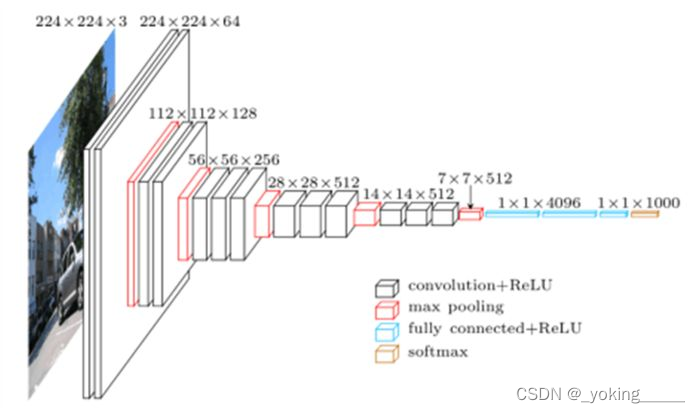
- 这里如果直接使用VGG-16的网络框架拟合效果很差,会出现较为明显的过拟合现象,如下图,是直接使用原始框架训练时的误差以及Acc.的情况:
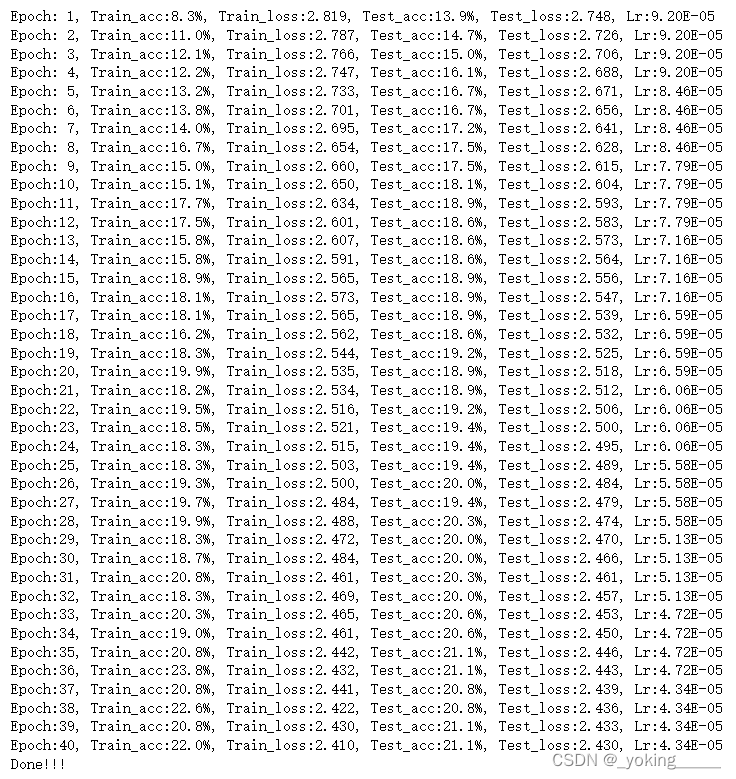

- 可以看到误差在2左右,而精确度只有20%左右
因为训练数据只有1800张图片,而对于VGG-16网络来说,可能数据量不够,所以需要调整网络,防止过拟合!!
网络改进如下:
- 添加BN层:Batch_Norm的作用
- 调整图片的尺寸,从224x224调整到256x256
- 减小全连接层神经元的数量
第一次训练结果:采用13个卷积层的训练结果
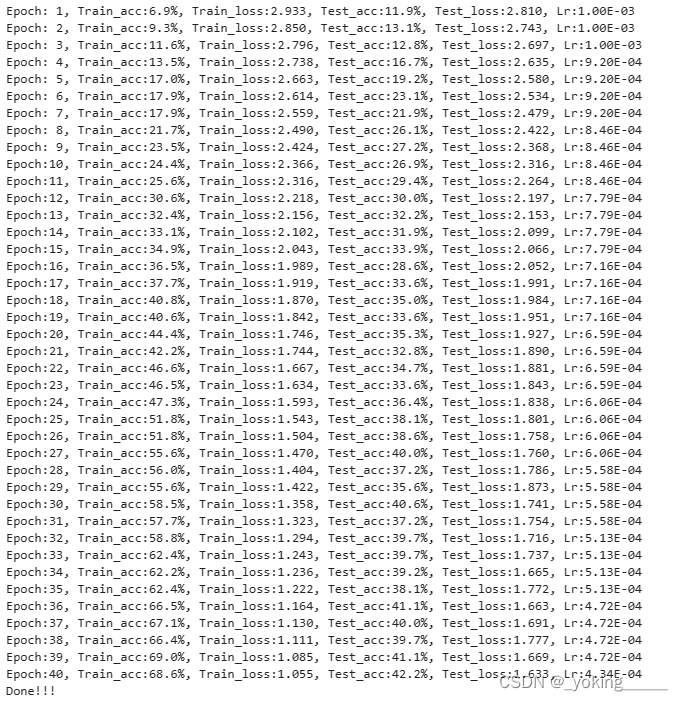
Loss and Acc.

预测:
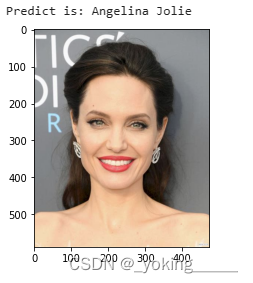
第二次训练结果:采用9个卷积层的训练结果
(多训练了几次:))
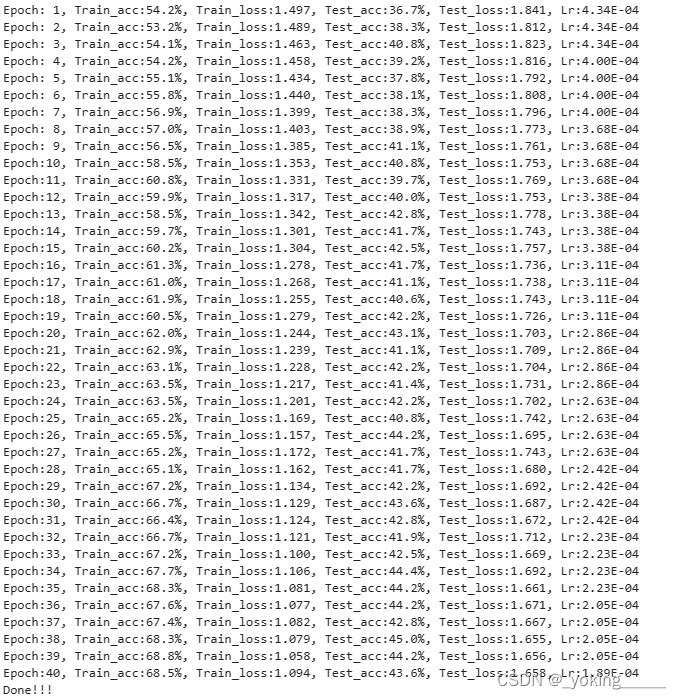
Loss and Acc.

预测:
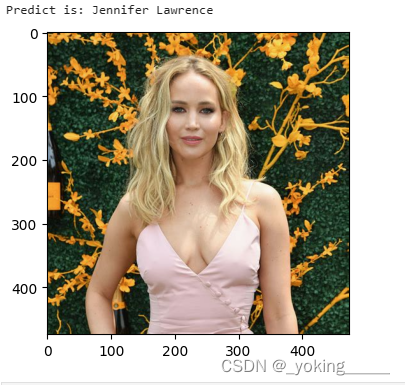
修改之后的网络结构如下:
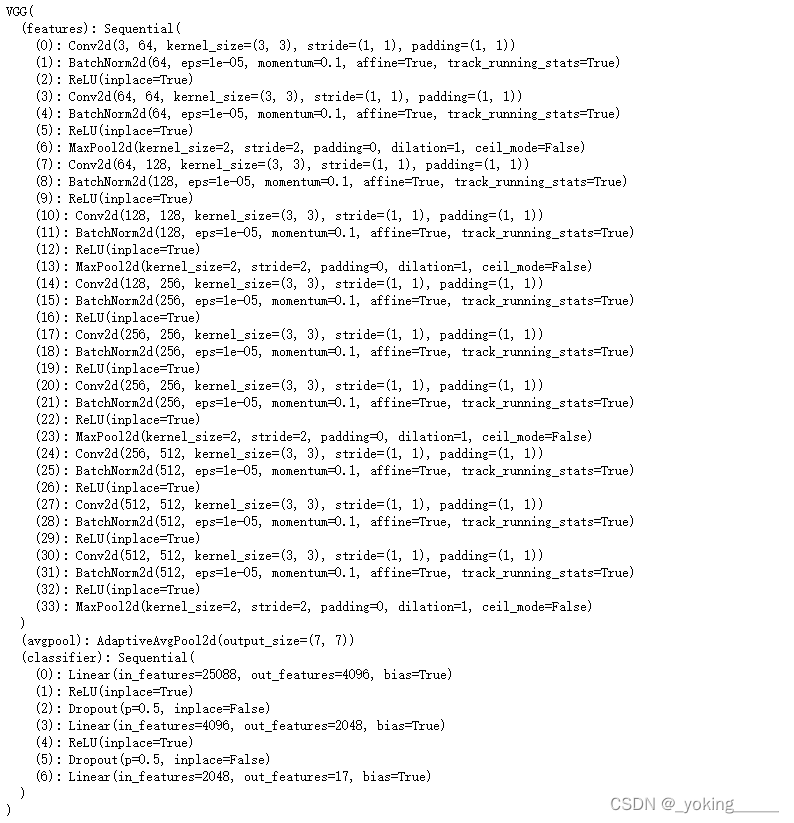
完整VGG-16调整网络结构代码:(可能有点蠢的方式)
# 构建VGG-16
from torchvision.models import vgg16
model = vgg16(pretrained=False).to(device)
for param in model.parameters():
param.requires_grad = True
# 添加BatchNorm层
model.features._modules['1'] = nn.BatchNorm2d(64, eps=1e-05, momentum=0.1,
affine=True, track_running_stats=True)
model.features._modules['2'] = nn.ReLU(inplace=True)
model.features._modules['3'] = nn.Conv2d(64, 64, kernel_size=(3, 3),
stride=(1, 1), padding=(1, 1))
model.features._modules['4'] = nn.BatchNorm2d(64, eps=1e-05, momentum=0.1,
affine=True, track_running_stats=True)
model.features._modules['5'] = nn.ReLU(inplace=True)
model.features._modules['6'] = nn.MaxPool2d(kernel_size=2, stride=2,
padding=0, dilation=1, ceil_mode=False)
model.features._modules['7'] = nn.Conv2d(64, 128, kernel_size=(3, 3),
stride=(1, 1), padding=(1, 1))
model.features._modules['8'] = nn.BatchNorm2d(128, eps=1e-05, momentum=0.1,
affine=True, track_running_stats=True)
model.features._modules['9'] = nn.ReLU(inplace=True)
model.features._modules['10'] = nn.Conv2d(128, 128, kernel_size=(3, 3),
stride=(1, 1), padding=(1, 1))
model.features._modules['11'] = nn.BatchNorm2d(128, eps=1e-05, momentum=0.1,
affine=True, track_running_stats=True)
model.features._modules['12'] = nn.ReLU(inplace=True)
model.features._modules['13'] = nn.MaxPool2d(kernel_size=2, stride=2,
padding=0, dilation=1, ceil_mode=False)
model.features._modules['14'] = nn.Conv2d(128, 256, kernel_size=(3, 3),
stride=(1, 1), padding=(1, 1))
model.features._modules['15'] = nn.BatchNorm2d(256, eps=1e-05, momentum=0.1,
affine=True, track_running_stats=True)
model.features._modules['16'] = nn.ReLU(inplace=True)
model.features._modules['17'] = nn.Conv2d(256, 256, kernel_size=(3, 3),
stride=(1, 1), padding=(1, 1))
model.features._modules['18'] = nn.BatchNorm2d(256, eps=1e-05, momentum=0.1,
affine=True, track_running_stats=True)
model.features._modules['19'] = nn.ReLU(inplace=True)
model.features._modules['20'] = nn.Conv2d(256, 256, kernel_size=(3, 3),
stride=(1, 1), padding=(1, 1))
model.features._modules['21'] = nn.BatchNorm2d(256, eps=1e-05, momentum=0.1,
affine=True, track_running_stats=True)
model.features._modules['22'] = nn.ReLU(inplace=True)
model.features._modules['23'] = nn.MaxPool2d(kernel_size=2, stride=2,
padding=0, dilation=1, ceil_mode=False)
model.features._modules['24'] = nn.Conv2d(256, 512, kernel_size=(3, 3),
stride=(1, 1), padding=(1, 1))
model.features._modules['25'] = nn.BatchNorm2d(512, eps=1e-05, momentum=0.1,
affine=True, track_running_stats=True)
model.features._modules['26'] = nn.ReLU(inplace=True)
model.features._modules['27'] = nn.Conv2d(512, 512, kernel_size=(3, 3),
stride=(1, 1), padding=(1, 1))
model.features._modules['28'] = nn.BatchNorm2d(512, eps=1e-05, momentum=0.1,
affine=True, track_running_stats=True)
model.features._modules['29'] = nn.ReLU(inplace=True)
model.features._modules['30'] = nn.Conv2d(512, 512, kernel_size=(3, 3),
stride=(1, 1), padding=(1, 1))
model.features.add_module('31', nn.BatchNorm2d(512, eps=1e-05, momentum=0.1,
affine=True, track_running_stats=True))
model.features.add_module('32', nn.ReLU(inplace=True))
model.features.add_module('33', nn.MaxPool2d(kernel_size=2, stride=2,
padding=0, dilation=1, ceil_mode=False))
# model.features.add_module('34', nn.Conv2d(512, 512, kernel_size=(3, 3), stride=(1, 1), padding=(1, 1)))
# model.features.add_module('35', nn.BatchNorm2d(512, eps=1e-05, momentum=0.1, affine=True, track_running_stats=True))
# model.features.add_module('36', nn.ReLU(inplace=True))
# model.features.add_module('37', nn.Conv2d(512, 512, kernel_size=(3, 3), stride=(1, 1), padding=(1, 1)))
# model.features.add_module('38', nn.BatchNorm2d(512, eps=1e-05, momentum=0.1, affine=True, track_running_stats=True))
# model.features.add_module('39', nn.ReLU(inplace=True))
# model.features.add_module('40', nn.Conv2d(512, 512, kernel_size=(3, 3), stride=(1, 1), padding=(1, 1)))
# model.features.add_module('41', nn.BatchNorm2d(512, eps=1e-05, momentum=0.1, affine=True, track_running_stats=True))
# model.features.add_module('42', nn.ReLU(inplace=True))
# model.features.add_module('43', nn.MaxPool2d(kernel_size=2, stride=2, padding=0, dilation=1, ceil_mode=False))
# 减小全连接层神经元的个数
model.classifier._modules['3'] = nn.Linear(4096, 4096//2)
model.classifier._modules['6'] = nn.Linear(4096//2, len(classNames))
model.to(device)
model
三、训练模型
1.设置超参数
lr = 1e-3
lambda1 = lambda epoch : 0.92 **(epoch // 4)
optimizer = torch.optim.SGD(model.parameters(), lr=lr)
scheduler = torch.optim.lr_scheduler.LambdaLR(optimizer, lr_lambda=lambda1)
2.编写训练函数
def train(dataloader, model, loss_fn, optimizer):
size = len(dataloader.dataset)
num_batches = len(dataloader)
train_loss, train_acc = 0, 0
for X, y in dataloader:
X, y = X.to(device), y.to(device)
# loss
pred = model(X)
loss = loss_fn(pred, y)
# back
optimizer.zero_grad()
loss.backward()
optimizer.step()
# log
train_loss += loss.item()
train_acc += (pred.argmax(1) == y).type(torch.float).sum().item()
train_acc /= size
train_loss /= num_batches
return train_acc, train_loss
3.编写测试函数
def test(dataloader, model, loss_fn):
size = len(dataloader.dataset)
num_batches = len(dataloader)
test_loss, test_acc = 0, 0
with torch.no_grad():
for imgs, target in dataloader:
imgs, target = imgs.to(device), target.to(device)
# loss
target_pred = model(imgs)
loss = loss_fn(target_pred, target)
test_loss += loss.item()
test_acc += (target_pred.argmax(1) == target).type(torch.float).sum().item()
test_acc /= size
test_loss /= num_batches
return test_acc, test_loss
4.正式训练
import copy
loss_fn = nn.CrossEntropyLoss()
epochs = 40
train_loss, train_acc = [], []
test_loss, test_acc = [], []
best_acc = 0
for epoch in range(epochs):
model.train()
epoch_train_acc, epoch_train_loss = train(train_dl, model, loss_fn, optimizer)
scheduler.step()
model.eval()
epoch_test_acc, epoch_test_loss = test(test_dl, model, loss_fn)
if epoch_test_acc > best_acc:
best_acc = epoch_test_acc
best_model = copy.deepcopy(model)
train_acc.append(epoch_train_acc)
train_loss.append(epoch_train_loss)
test_acc.append(epoch_test_acc)
test_loss.append(epoch_test_loss)
lr = optimizer.state_dict()['param_groups'][0]['lr']
template = "Epoch:{:2d}, Train_acc:{:.1f}%, Train_loss:{:.3f}, Test_acc:{:.1f}%, Test_loss:{:.3f}, Lr:{:.2E}"
print(template.format(epoch+1,
epoch_train_acc*100, epoch_train_loss,
epoch_test_acc*100, epoch_test_loss,
lr))
PATH = './best_model.pth'
torch.save(model.state_dict(), PATH)
print('Done!!!')
四、结果可视化
1.Loss和Accuracy图
import matplotlib.pyplot as plt
import warnings
warnings.filterwarnings("ignore")
plt.rcParams['font.sans-serif'] = ['SimHei']
plt.rcParams['axes.unicode_minus'] = False
plt.rcParams['figure.dpi'] = 100
epochs_range = range(epochs)
plt.figure(figsize=(12, 3))
plt.subplot(1, 2, 1)
plt.plot(epochs_range, train_acc, label='Train Acc.')
plt.plot(epochs_range, test_acc, label='Test Acc.')
plt.legend(loc='lower right')
plt.title('Training and Validation Accuracy')
plt.subplot(1, 2, 2)
plt.plot(epochs_range, train_loss, label='Train Loss')
plt.plot(epochs_range, test_loss, label='Test Loss')
plt.legend(loc='lower right')
plt.title('Training and Validation Loss')
plt.show()
2.指定图片进行预测
from PIL import Image
classes = list(total_data.class_to_idx)
def predict_one_image(image_path, model, transform, classes):
test_img = Image.open(image_path).convert('RGB')
plt.imshow(test_img)
test_img = transform(test_img)
img = test_img.to(device).unsqueeze(0)
model.eval()
output = model(img)
_, pred = torch.max(output, 1)
pred_class = classes[pred]
print(f'Predict is: {pred_class}')
predict_one_image(image_path='./data/Jennifer Lawrence/009_bcd380a7.jpg',
model=model,
transform=train_transforms,
classes=classes
)

参考:
VGG16_BN网络框架






















 1330
1330











 被折叠的 条评论
为什么被折叠?
被折叠的 条评论
为什么被折叠?








